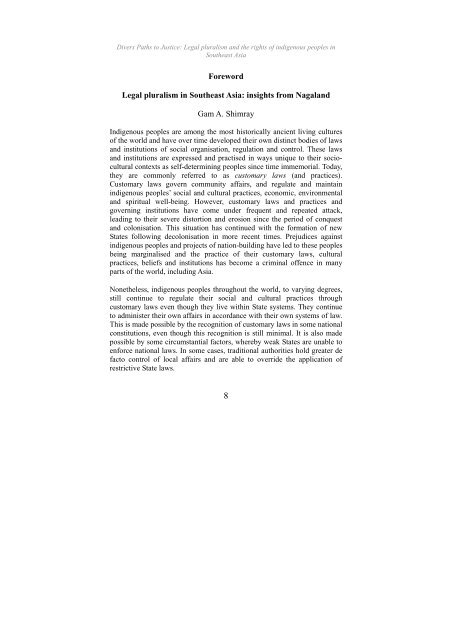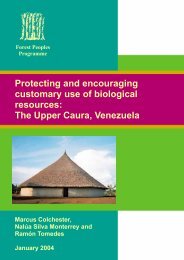Divers Paths to Justice - English - Forest Peoples Programme
Divers Paths to Justice - English - Forest Peoples Programme
Divers Paths to Justice - English - Forest Peoples Programme
You also want an ePaper? Increase the reach of your titles
YUMPU automatically turns print PDFs into web optimized ePapers that Google loves.
<strong>Divers</strong> <strong>Paths</strong> <strong>to</strong> <strong>Justice</strong>: Legal pluralism and the rights of indigenous peoples inSoutheast AsiaForewordLegal pluralism in Southeast Asia: insights from NagalandGam A. ShimrayIndigenous peoples are among the most his<strong>to</strong>rically ancient living culturesof the world and have over time developed their own distinct bodies of lawsand institutions of social organisation, regulation and control. These lawsand institutions are expressed and practised in ways unique <strong>to</strong> their socioculturalcontexts as self-determining peoples since time immemorial. Today,they are commonly referred <strong>to</strong> as cus<strong>to</strong>mary laws (and practices).Cus<strong>to</strong>mary laws govern community affairs, and regulate and maintainindigenous peoples’ social and cultural practices, economic, environmentaland spiritual well-being. However, cus<strong>to</strong>mary laws and practices andgoverning institutions have come under frequent and repeated attack,leading <strong>to</strong> their severe dis<strong>to</strong>rtion and erosion since the period of conquestand colonisation. This situation has continued with the formation of newStates following decolonisation in more recent times. Prejudices againstindigenous peoples and projects of nation-building have led <strong>to</strong> these peoplesbeing marginalised and the practice of their cus<strong>to</strong>mary laws, culturalpractices, beliefs and institutions has become a criminal offence in manyparts of the world, including Asia.Nonetheless, indigenous peoples throughout the world, <strong>to</strong> varying degrees,still continue <strong>to</strong> regulate their social and cultural practices throughcus<strong>to</strong>mary laws even though they live within State systems. They continue<strong>to</strong> administer their own affairs in accordance with their own systems of law.This is made possible by the recognition of cus<strong>to</strong>mary laws in some nationalconstitutions, even though this recognition is still minimal. It is also madepossible by some circumstantial fac<strong>to</strong>rs, whereby weak States are unable <strong>to</strong>enforce national laws. In some cases, traditional authorities hold greater defac<strong>to</strong> control of local affairs and are able <strong>to</strong> override the application ofrestrictive State laws.8
















